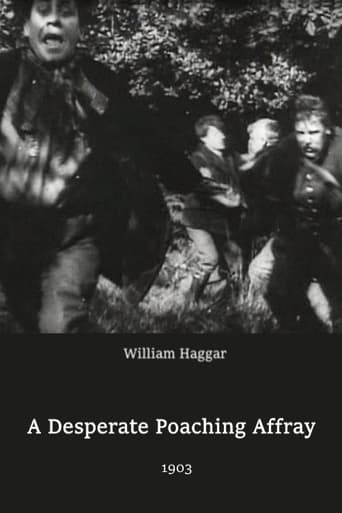boblipton
Men with guns flee from other men, police and dogs in this film by Walter Hagar.One of the IMDb reviews claims this is the first chase film. My immediate reaction to any claims of a cinematic first is denial, but a brief search shows that fellow British director, Alf Collins, who was accounted a specialist in chases, released his first chase film a month later. Then I remembered A DAYLIGHT ROBBERY, which had been released in July of that year.... and I await reports of earlier examples. Regardless of who was first, it wouldn't take long for the genre to ripen. The following year there would be chase comedies, like HOW A FrENCH NOBLEMAN FOUND A WIFE THROUGH THE 'NEW YORK HERALD' PERSONAL ADVERTISEMENTS.It's also a very advanced movie for 1903, starting off with a panning shot in the first of five scenes.PS: About twenty minutes after writing this review, I looked at James Williamson's 1901 STOP, THIEF in which a housewife chases a tramp who has stolen a leg of lamb.
Cineanalyst
"A Desperate Poaching Affray" is an early and innovative chase and crime film. This early cinema genre of crime chases seems to have been invented in Britain. James Williamson's "Stop Thief!" (1901) is the earliest I know of that could be attributed to the genre. By 1903, British filmmakers made "A Daring Daylight Robbery", "Robbery of the Mail Coach" and this film, all of which heavily influenced the adoption of the genre across the Atlantic, most notably influencing "The Great Train Robbery" made later that year. "Desperate Poaching Affray" was an especially internationally popular subject: 480 prints were sold and more dupes were made in the U.S. (Michael Chanan, "Economic Conditions in Early Cinema" in "Early Cinema: Space, Frame, Narrative") Comedic chase films that came later would use the film techniques and grammar invented in these films.The chase in this film, law enforcement chasing after poachers (and they all have guns), is clumsy and the actors are noticeably amateurs, but what's exceptional about this picture, for its time, is its continuity editing, as well as some novel camera placement. It only consists of seven shots and lasts for only two to three minutes. Yet, there is some panning, untraditional camera placement and staging--where we see the actors approach and pass right by the camera in depth--and the earliest extended use of reverse-angle shots I know of (there are brief earlier examples, such as in "Attack on a China Mission" (1900)).The first shot throws us right into the action. The poachers attempt to hide in some brush. The authorities approach from off-screen and into the frame. A pan allows the camera to follow the action as the chase begins. The second and third shots, as well as the third and fourth, are reverse-angle takes, where the pursued and pursuers run by the camera and into off-screen space, followed by a cut, with a framing of the action from the opposite, 180-degree angle to follow the action. The last three cuts and camera placements follow the action in a fluid continuous manner, with the direction of the chase following the rules of the axis of action. The exceptional, modern continuity of this film--the harmony of the action, camera placement and editing--was unrivaled for years to come.
Snow Leopard
There's a lot of action in this short feature that makes it worth watching even though it is pretty unrefined. The "Desperate Poaching Affray" begins when a couple of game poachers are spotted, and then the chase is on. Quite a bit happens after that, and it packs a lot of activity into just a few minutes of running time. The emphasis is certainly on the action, as most of the actors just race around without trying too hard to make their actions seem believable. But there's no denying that you want to see how it comes out, and anyway, most of the so-called action movies made today have even lower acting quality and plausibility standards, without being nearly so efficient as this one is in terms of actual entertainment value.
Alice Liddel
Unlikely as it might seem, this knockabout farmyard shootout is a precursor to the forbiddingly austere cinema of Robert Bresson - in its use of non-professional actors; and in its opening poaching scene, repeated in the master's 'Mouchette'. And, although this marvellous film is full of vivid action, brutal fisticuffs, fiery shootouts, and pond dunkings, with the breathless cast effectively tumbling the audience into the drama by hurling themselves in our direction, its vision of rural life is as bleak as Bresson's, an anti-pastoral in which the immemorial, supposedly natural and calm countryside becomes a frightening labyrinth of violence, power and murder.The film shows how a couple of harmless poachers are turned by circumstance into killers, a circumstance needlessly engineered by the forces of reaction. The boys only want to steal a bit of grub, it's not as if the landlord would miss it; but the minute they step onto his land, they are chased by class-traitor labourers and then the police.
it would be wrong to call this Kafkaesque - they are clearly guilty - but this proliferation of law-defenders is nightmarish. They manage to use their ironically superior knowledge of someone else's land to evade capture; but eventually, like the Soviets at Stalingrad, sheer, faceless numbers win through. The momentum of the action, the harsh vibrancy of the sun-whipped landscape, and the gusto of the actors all create a sense of fun and exhiliration that is at the same time harrowing.It would be pompous to ascribe social critique to such a venture, but there is something very, very wrong about the propertied classes and their stoolies here.
